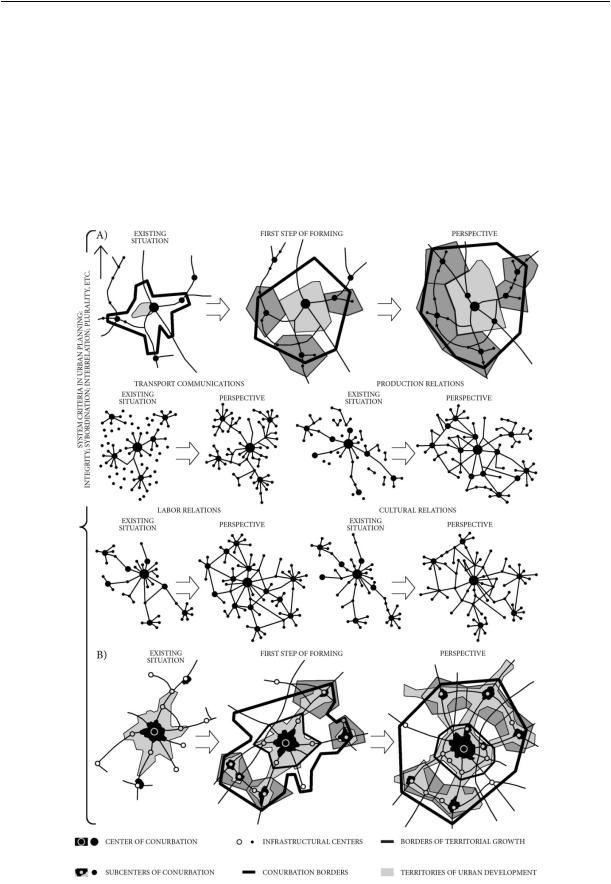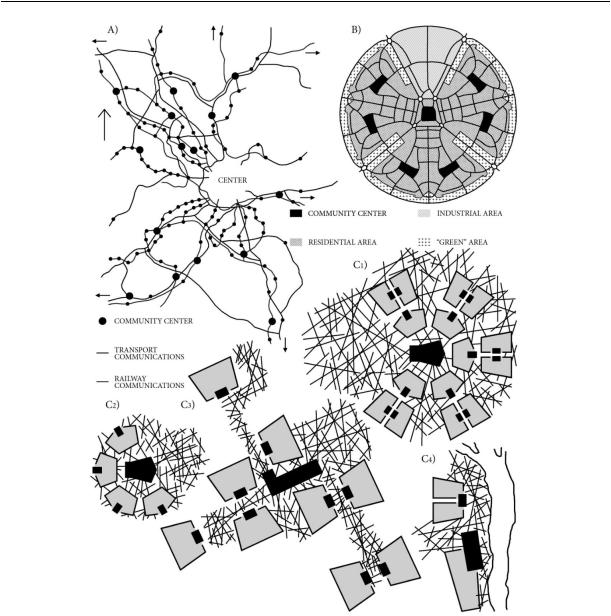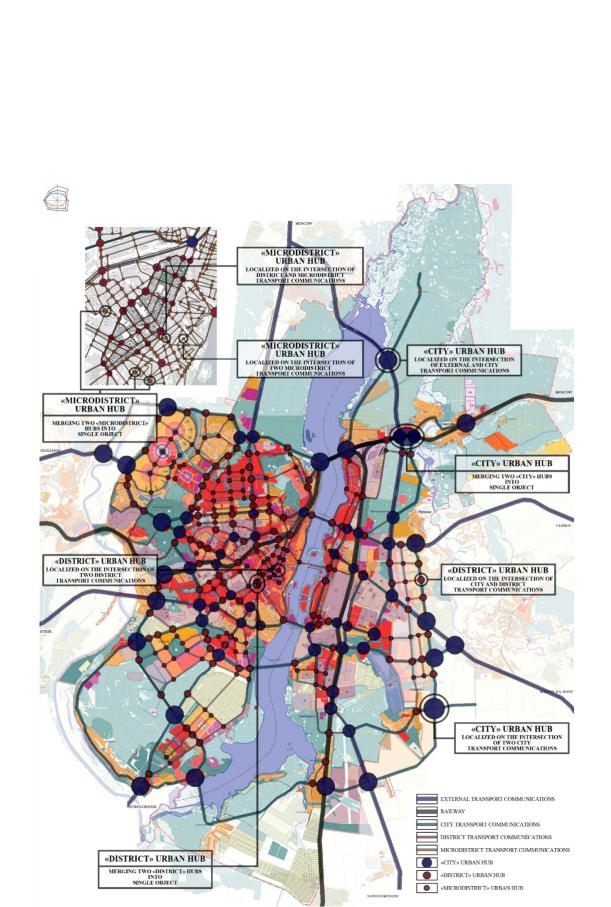
3553
.pdf
Issue № 1(33), 2017 |
ISSN 2542-0526 |
UDC 711.00
A. E. Yenin1, A. V. Liventceva2
SYSTEM APPROACH IN URBAN PLANNING. HISTORY. GENERAL FOUNDATIONS. OBJECTS OF SYSTEM RESEARCHES
Voronezh State Technical University
Russia, Voronezh, +7 (4732) 71-53-21, e-mail: a_yenin@mail.ru, liventseva.av@gmail.com 1PhD of architecture, director of Architectural and Town Planning Institute,
dean of the chair “Bases of design and architectural graphics” 2Teacher’s assistant on the chair "Bases of design and architectural graphics"
Statement of the problem. The main goal of the research is to identify general principles of system approach in urban planning. Attention is given to the history of system methodology and its adaptation to the goals of urban planning science and urban design.
Results and conclusions. The authors analyzed the most important modern directions of system approach in the field of urban planning and mainly its implementation. The aspect of the big cities functional and spatial structure’s complication is described. Such planning elements of cities’ structural framework as urban hubs, spaces and axes are identified. Among them, according to the authors, the most important elements are urban hubs, i.e. functional focuses of the framework. “Town center” (or urban hub) cannot be only the historical central part of the city any more. Nowadays, it is much more correct to speak about the system of town centers. That is why it is necessary to use the systematic approach in the process of urban hubs’ structural framework development.
Keywords: systematic approach, urban hub, city’s structural framework urban hub.
Introduction
Big cities are complex social and economic systems; they consist of different components with a huge number of functional communications [13]. The behaviour of these systems is characterized by such features as counterintuitive changes, insensibility to changes; resistance to innovations; chaotic development, etc. [26]. According to these statements, it is necessary to apply system methodology in different urban studies. The systematic method has different tools which are much more suitable to the modern tasks of urban planning.
The systematic approach (General Systems Theory) as the new scientific methodology was proposed in the 1930s by Ludwig von Bertalanffy and based on the philosophy of Leibniz, earlier scientific works of Bogdanov and other researchers. However, Ludwig von Bertalanffy was the first who finally proposed the idea of isomorphism.
© Yenin A. E., Liventceva A. V., 2017
91

Russian journal of building construction and architecture
Functional representation of the object actuallymeans synthesizing of various characteristics into coherent picture ("function" is understood as communication that defines inclusion of different parts in one whole). A set of functions presents an object as a hierarchically organized system. Moreover, the functional approach deals with concepts of structure and organization.
Systematic approach in urban planning
Analysis of functioning and development has the great value in identification of urban structures’ behavior. A function shows properties of the system [13]. There is only one way to understand the system, i.e. to analyse its structure. Functions can exist only in a structure [15]. A lot of significance is given to the hierarchical structure of the system, because it describes all the parts of a system. Functions of the system are the integrated result of its components’ functioning [17]. The structural approach deals with the problems of order and organization. The analysis of functioning illustrates the current state. Meanwhile a structure is not a dead replica of the object but is characteristic of invariant aspects, which is revealed only in the analysis of an object’s dynamics [19]. Therefore, the analysis of development is important in describing the system behavior.
Urban systems modeling makes it possible to construct invariant structures of functional and spatial organization and choose the most effective one.
Currently science provides two types of modeling: mental and material ones. Mental modelingis is implemented in the first and general stages of research. Material modeling is necessary for reproducing a structure, character and nature of architectural objects [12].
Material modeling and its models can be divided into three types: geometric (spatial), physical (based on the measurement of space and time) and structurally or functionally similar to the simulated object (mathematics).
A system must match the number of criteria for their modeling implementation:
As for the integrity or unity of components’ goal, Dokuchaev, Soviet theoretician and practitioner of architecture, wrote about the objective function of urban planning: "master plan and projects of areas renovation must be drawn up with certain idea that fit cultural, social and public value of the city. Different projects must be conformed to the idea of urban modernization, including economic, technical and utilitarian aspects" [4, p. 191].
There is plurality of components which perform various systematic functions. This principle is shown in Charles Landry’s research. Using the example of Classic Italian "Piazza", like Piazza del Campo in Siena, the author tells us about its multicomponent organization. Four sides of the square symbolize the essence and interaction of urban power and prosperity. On
92

Issue № 1(33), 2017 |
ISSN 2542-0526 |
one side is the Cathedral symbolizing spirituality; on another one is the Museum, library or University symbolizing education, knowledge and culture; on the third one is the City hall or Palace demonstrating power of government; and finally on the fourth one a market or shopping mall representing economic development. The area in the middle is the intersection point of news, gossip, any kind of human communication. This urban concept is still applied in European countries [11].
––a hierarchical structure in which connections and interactions of components are implemented from the lowest to the highest level. Harvey S. Perloff wrote that the question of priority is very important as the city can handle at one time the development of one or two planning objects. However, it is not advisable to implement only one project and expect outstanding results. Attention should be focused on urban environment as a whole [21].
––Coherent connections between elements, i.e. changes in one have an impact on the parameters of the other elements and, as a rule, are nonlinear. Zholtovsky wrote "... it is the law of unity, subduing the diversity of its constituent elements… Artist should always start from whole to parts, even in cases when he is working with a separate element, such as a living cell or house" [3, p. 38].
History of methodology
One of the leading architects of the 20th century, Fomin wrote about the impact of solving unsystematic urban problems: "the whole century of chaotic town planning with uncontrolled residential development has led to the worst sanitary and design conditions" [3, p. 119] (about St. Petersburg).
Nevertheless, since 1919 (when Fomin pointed out the unsystematic town planning methods) till now, methodological base of town planning has changed a lot. P. Hall noticed that urbanism as a discipline has changed during ten years from 1960 to 1970 more than in previous hundred, maybe a thousand years. The object of the discipline changed from some kind of craft based on personal knowledge and set of some rudimentary concepts to scientific approaches. A town planner was able to create systems and control them. Cities and regions are now analyzed as a complex system – in fact, as spatial objects, which include number of subsystems. Urban development nowadays is scientific activity that serves as a process of monitoring and verification of urban subsystems. All of this was based on the new science –– cybernetics founded by N. Wiener [5] (Fig. 1).
The transition to the new method of town planning was carried out in several stages. Firstly, scientists formulated the general goal of the urban transport system. Then they analyzed the current state and problems of the urban transport network. They founded the dependence of traffic
93

Russian journal of building construction and architecture
flows from various activities (in mathematical equations). This allowed one to make projections of the transport system and search for alternative solutions for its improvement. This method of research leads to the possibilityof numerous checks and adjustments of a system’s states.
The developed “step-by-step” strategy has influenced the development of the methodological concept that helped to find the “best” localization for the components of such urban systems as commercial, industrial, residential, etc. Localization of objects had to rely on the existing transport plan of the city/region.
Fig. 1. Systemic nature of town planning [25, c. 21––22]:
a) Structure of big conurbations; b) Structure of medium and small conurbations
94

Issue № 1(33), 2017 |
ISSN 2542-0526 |
In the 1960s, this approach meant appearance of the fundamentally new theoretical and practical concepts. "Drawing" approach used at the time, which represented designing objects from nothing, was replaced by the approach in which urban development was seen as a process. It was a radically new method of decision making and consisted of series operations such as the identification of urban objects’ goals; analysis and monitoring of environmental changes; making proposals for alternative development; implementation of alternative solutions; regulation of functioning and development. The principles of this approach formulated by students of the Manchester University were presented in detail in British textbooks on urban planning.
Moreover, according to Charles Landry, a metaphor that reflect current scientific views is mapping city with an organism. This mapping represents paradigm shift, i.e. focus on balance, mutual dependence and interaction of urban components. Such a vision contrasts with the modernist metaphor, namely, with the idea of the city as machine. The result is an emphasis on health and people, rather than on theinfrastructure, buildings and urban objects [11].
However, the development of both representations is investigated. The comparison of an organism and a car began by Descartes in the first decade of the 17th century, though it did since Plato as these analogies can be found. The ideas about a body as a car were supported by the methods of reductionism in biology. Today dogmatic belief in this metaphor is based on two factors, i.e. development of molecular biology over the past fifty years and technological development during the same period [6]. The most appropriate method for urban environment with the aim of finding a solution for its development and modernization, which is to combine both views. It is impossible to deny such criteria as balance, mutual dependence and interaction of urban components. Analysis of criteria and regulations ofurban violations is possible in case of detailed (mathematical) studies.
Yargina, Kositsky and Vladimirov revealed that: "urban systems are products of construction industry, complex artificial systems. However, they are systems of a special kind, characterized by: attachment to the territory, huge sizes and inclusion of artificial and natural components. Therefore, urban systems are attributed to natural-anthropogenic systems" [27, p. 14]. These conclusions show researchers existence of three subsystems – population, artificial environment, natural environment in the structure of a single system.
Examples of systematic studies of town planning
Integration of urban functions causes appearance of multifunctional urban territories. That is why urban zoning by analyzing general functional process is not possible anymore. Classi-
95

Russian journal of building construction and architecture
fying different urban areas, it is necessary to analyze the intensity of their functional processes. An urban structure consists of three types of urban space: hub, surface, axis. An urban hub is characterized by an intense flow of functional processes and it concentrates population in one point.
Less intensive functional processes that localize population across the territory characterize an urban surface. Functional processes of urban axes are the processes that organize population expressed by a linear extent in space. Hubs, surfaces and axes in their unity and interconnection form the integral functional and spatial structure of the city, or its urban framework.
Moreover, studying of functional and spatial urban structure becomes one of the main tasks for specialists, as this is important for urban development management. "Planning structure is always illustrated in the scheme of urban transport communications and associated with the structure of public centers. To these axes and centers gravitate intensively developed urban areas. In combination, they form basis for territorial planning and urban organization –– creation of urban framework [17].
With the urban growth, city and its framework become more complicated because of the transformation of spatial and functional relations, their quantity etc. A city takes the form of a polycentric structure that is expressed in the structural formation of urban hubs. Nowadays historical city center is connected with different infrastructural subcenters. Studying the principles of urban spatial and functional formation is one of the most important tasks for urban planners (Fig. 2).
In modern urban development concept "center" no longer fits the ideas about the most intensively developed area of the historic core. It is more correct to speak about the system of centers, including urban hubs. The formation of the urban structural framework and the system of urban hubs will balance and harmonize urban functional and spatial organization, and thus sociology. In this approach, Central part of the city and its periphery do not contradict each other but create single functional and spatial structure of the urban environment. In this case historical center district is one of the elements of the system.
According to Pereni (scientist who studied polycentric tendencies in the 1970s), one of the fundamental tasks during agglomerations’ reconstruction is development of an urban center system which necessitates transformation of residential areas into their rational system. This does not mean complete transformation of agglomerations into a single "body", abandoning the idea of codependent residential areas" [22].
96

Issue № 1(33), 2017 |
ISSN 2542-0526 |
Fig. 2. Polycentric urban structures: a) Polycentric development of Stockholm (according to Master plan 2050) [26, p. 288]; b) New town structure[27, p. 9];c1––c4) Connections between community centers [23, p. 21]: c1) City; c2) Small town; c3) Conurbation; c4) City with natural or artificial water object
Formation of the urban hubs’ system in Voronezh city (Russia)
Following the Soviet Union period, Russian Federation lost its “second cities” such as Kiev, Minsk, Baku, etc. In this situation, country faced the problem of new megalopolises’ development [13, 28, 29, 31]. This is still necessary for the creation of the settlement’s framework as a part of the new geopolitical space. According to this condition, Voronezh city becomes one of the main urban centers such as Yekaterinburg, Kazan, and Nizhny Novgorod, etc.
The concept of urban hub’s system (Fig. 3) is based on textual and illustrative materials of the city’s Master plan (stated in 2008 and in force until 2020).
97

Russian journal of building construction and architecture
One of the basic concepts in the process of system’s formation is dependence of an urban hub rank (the number of objects in its structure, its spatial development, etc.) on the rank of transport communications in the structure of which intersection it is localized. In other words, the concept of the city’s transport framework influences the concept of urban hubs’ system. The development of the latter is subordinated to any particular scenario of the transport framework and has numerous variants of the development.
Fig. 3. Urban hubs’ system. Voronezh city (Russian Federation)
98

Issue № 1(33), 2017 |
ISSN 2542-0526 |
Today experts often note the development of a multicomponent transport structure. It is difficult to imagine a modern city without inclusion of air-, railway-, public and individual transport networks [14, 28, 31]. According to this, formation of the urban hubs is one of the top-priority goals in the development of the city’s infrastructure. Such hubs serve as a transfer point of different types of external and internal transport including their structure, as a rule, stations of different transports and numerous of other infrastructural objects.
The structural framework of the system of Voronezh urban hubs is based on the simplified scheme of the city’s transport infrastructure. In initial materials, a more extensive typology of the main streets and roads is carried out: external transport networks, internal highways, internal transport networks with traffic lights, district transport networks and central transport network. For the sake of simplification of the initial typology of the main streets and roads, the following typology of transport communications is presented in the new scheme: external transport networks, city transport networks, district transport networks, microdistrict/quarter transport networks.
The structural framework of the urban hub system illustrates the location of different hubs, among them are hubs with the “City” rank, hubs with the “District” rank [15].
The total number of potential “City” hubs is 60, among them 20 are located in the territory without any buildings and 40 are part of the structure of existing urban environment.
In the first case, it is possible to design an urban hub “from a blank sheet” which certainly gives a designer more opportunities to create a multicomponent infrastructure. In the second case, it is necessary to consider existing objects. The principles of a system formation of urban objects are directed to the implementation of the step-by-step reconstruction and modernization of urban hubs due to systematic saturation of their structure by new elements, replacement and elimination of existing. Such an approach leads to the step-by-step “reorganization” of an urban environment.
The total number of “District” urban hubs is 212, the prevailing majority is localized in structure of existing urban environment. The principles of their formation is similar to those of the formation of the “District” urban hubs.
Analysis of the components of the structural framework showed a ratio of urban hubs. According to the principles of hierarchical structuring, the quantity of components of each level increases in the process of consideration from the highest to the lowest levels.
For the urban environment, both are important, i.e. existence of various profile objects of a city value (in the structure of the “City” hubs) as they meet the requirements of the entire
99

Russian journal of building construction and architecture
population and local infrastructural objects (in the structure of the“District” hubs). The number of “District” hubs has to be much higher according to the need of a five-minute availability of various services.
Conclusion
Experts regard the systematic approach, which focuses on studying various classes and types of systems, basic principles and regularities of their behavior and processes of their functioning and development, as the most effective method for solving various urban problems. In this case, urban environment is analyzed using three main defining characteristics: composition of the system (urban systems and their components that make up urban environment), structure (relationships of different parts as a whole), and environment in which all processes are organized (both external and internal ones). This of course leads to the consolidation of the basic idea, i.e. mapping the city with a complex object.
References
1.Avdotyin L. N., Lejava I. G., Smolyar I. M. Urban design. Moscow, Stroiizdat Publ., 1989. 432 p.
2.Afanas’ev V. Systematic and society. Moscow, Politizdat Publ., 1980.
3.Barkhin M. Masters of Soviet architecture about architecture. Moscow, Art. Publ., 1975, vol. 1.
4.Barkhin M. Masters of Soviet architecture about architecture. Moscow, Art. Publ., 1975, vol. 2.
5.Hall P. Cities of tomorrow: an intellectual history of urban planning and design in the twentieth century. Oxford, Blackwell Publishers Ltd, 1988. 502 p.
6.Haken H., Karlqvist A., Svedin U. The machine as metaphor and tool. Berlin, Springer-Verlag, 1993. 165 p.
7.Hauck T., Keller R., Kleinekort V. Infrastructural urbanism. Addressing the in-between. Berlin, DOM publishers, 2011. 335 p.
8.Hojer M., Gullberg A., Pettersson R., Ahlroth S. Images of the future city: time and space for sustainable development. Stockholm, Springer, 2011. 488 p.
9.Korotaev V. Formation of transport urban hubs as a main step of Moscow general plan’s realization. Urban planning, Moscow, 2014.
10.Kriken J. L., Enquist P., Rapaport R. City building. Nine planning principles for the twenty-first century. NY, Princeton Architectural Press, 2010. 260 p.
11.Landry C. The creative city: a toolkit for urban innovators. London, Earthscan Publications Ltd, 2000. 300 p.
12.Lavrik G. Methodological bases of regional planning. Introduction to demonology. Belgorod, BSTU. V. G. Shukhov. 2006.
13.Liventceva A., Yenin A. Analysis of modern tendencies in the field of the biggest cities reconstruction. Pershin publishing company. Tambov, 2014.
14.Liventceva A. Analysis of the transport structure. Implementation of the urban hub’s structural scheme on the example of Voronezh city. Architectural Researches. Voronezh, 2015.
15.Liventceva A. Principles of territorial-systematic and typological classification of the urban hubs. Scientific Herald of the Voronezh State University of Architecture and Civil Engineering, Voronezh.
100
